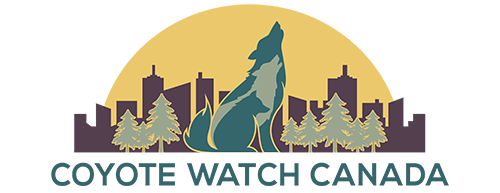Coyote Ecology

Did you know that the scientific name for the coyote is Canis latrans (Western coyote)?
- They are part of the Family Canidae which includes dogs, wolves, foxes, and jackals. The Family Canidae is referred to in general as the canids.
- Genetics from the Algonquin wolf (Eastern Wolf), Western Coyote and old dog DNA has contributed to the evolution of the Eastern Coyote, Canis latrans. There are references to the Eastern Coyote as being classified Canis latrans x lycaon and Canis latrans var.. This unique and historically significant genetic 'canid soup' is sometimes called a coywolf (Eastern coyotes are not half wolf and half coyote which the latter "nickname" suggests.)
- Weight ranges on average between 14-18kg (weigh-ins from field study data). The higher weight samples (17 - 19kgs) reflect coyotes that were FED by humans. The 17.5kg. coyote was ‘hand fed’ outside of a restaurant in the Hamilton Ontario area. The 19.5kg yearling was regularly baited with dead stock by a local farmer. Roadkill weight samples 300> over a span of two decades including geographic regions of southern Ontario and beyond Sudbury.
- Eastern coyotes mate for life when left to thrive; yearlings may take over a territory if the adult mated pair is killed or dies. Each family is unique and each individual influences territory fidelity and decision-making for survival.
- The male mate provides the necessary nourishment for the female during denning including regurgitating food for her (pups) to ingest. Coyotes demonstrate excellent skills as solitary/pair hunters and when rearing pups the parental male will provide much of the food. Male coyotes have been observed leading solitary lives after the death of their mate. Older siblings may return to the home range to help with the raising of their younger siblings. Co-caregiving is common within coyote families. Sharing of all the essential duties to maintain a safe and harmonious environment to protect and aren't vulnerable pups is a family affair.
- Coyotes form highly social, related family units. Family members share in the hunting, pup rearing and territory protection duties. Intact, established families are capable of hunting larger ungulate prey targeting weakened, unhealthy, or injured. Family size varies depending on habitat, available food sources, and human impact (urban/rural). Our past research concludes 2-4 adults (yearlings and parents), and pups, however, variations in size ‘cycle’ due to habitat/available food sources/mortality rates.
- Parents are key facilitators in teaching appropriate hunting-life skills to the pups. Juveniles dispersed in the fall (evidence of spring movement also) to establish their own territory, a juvenile may remain with the family to help rear next year’s pups. The Creekpark Pack demonstrated this behaviour over a two-year period.
- ‘Lone’ or transient individuals do occur-utilizing buffer areas around an established territory; however, survival may be more difficult for these loner animals.
- Vocalizations (howls, barks, throat growls, yips) are used to communicate between family and non-related members as well; defending territory, distress warnings, celebrating, locating family members, mating, and mourning the loss of a family member. Brief periods of interaction between previous family members of the Creekpark Pack during the study phase occurred. These unique communications or auditory illusions are often overestimated in terms of the number of coyotes that are actually vocalizing by the casual listener. This is known as the "beau geste effect".
- Vocalizations and proximity tolerance increased during these times.
- Although coyotes are classified as carnivores, their foraging and hunting behaviour is described more accurately as opportunistic or adaptive omnivores. They utilize carrion; a natural diet consists of mainly small mammals; rodents, rabbits, fruit, insects, nuts, insects, fish, human sources, and geese (eggs). Coyotes can become conditioned to livestock when proper farming deposal methods are not practiced. The lack of dead stock removal is a reliable attractant for all carrion feeders, especially canids.
- Human-associated feeding of wildlife, in particular, canids impacts behaviour on many levels e.g. encouraging wildlife to visit parking lots, parks, trails, backyards, shadowing/following people on trail systems, by roadways (this behaviour is not the same as an adult trying to move a human and/or dog away from a den area or rendezvous site during pup season - late March to September)
- When considering wildlife behaviour, be aware of seasonal milestones such as denning, dispersal, and mating.
- Consider implementing a Feeding Wildlife By-Law in your city or township. As an enforceable tool for prevention, this is an accessible option for communities that is effective at managing human behaviour and wildlife encounters.
- Coyotes are an integral aspect of a healthy and diverse ecosystem and provide a necessary prey/predator balance. Their contribution to zoonotic disease host species consumption deserves appreciation.
- Benefits to a farmer—Coyotes keep meso carnivores such as fox and raccoons in check and can potentially minimize crop damage by hunting abundant rodent populations. Predator-friendly ranching/farming techniques prove successful in creating practical and peaceful coexistence between people, livestock and predators.
- Mortality rates are very high, humans having the highest impact, vehicles second.
- Educational initiatives, wildlife proofing property, coexistence programs and public awareness about safety tips that include a factual overview about coyote behaviour, seasonal milestones and ecology, are progressive methods to foster sustainable and humane coexistence.

